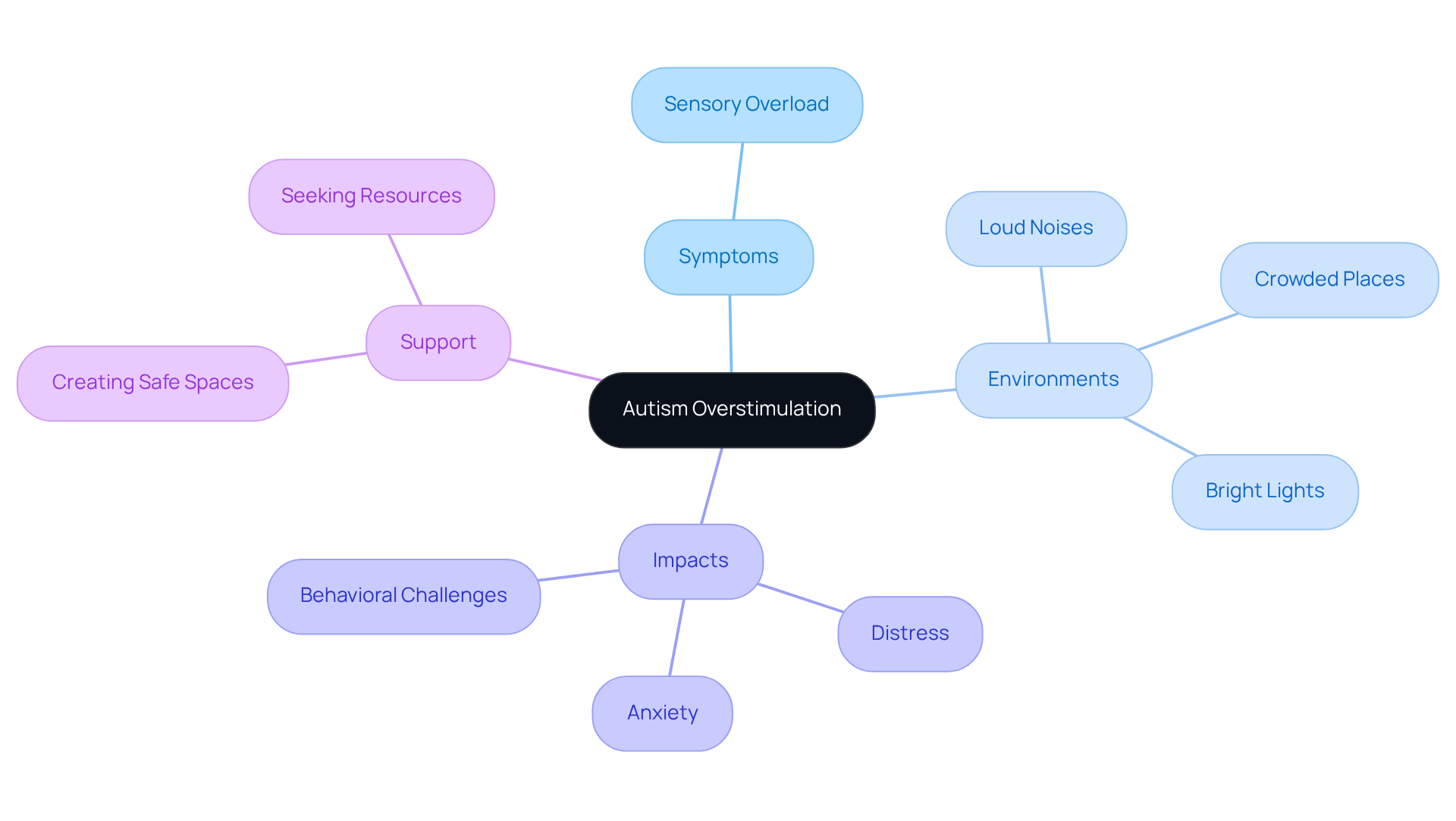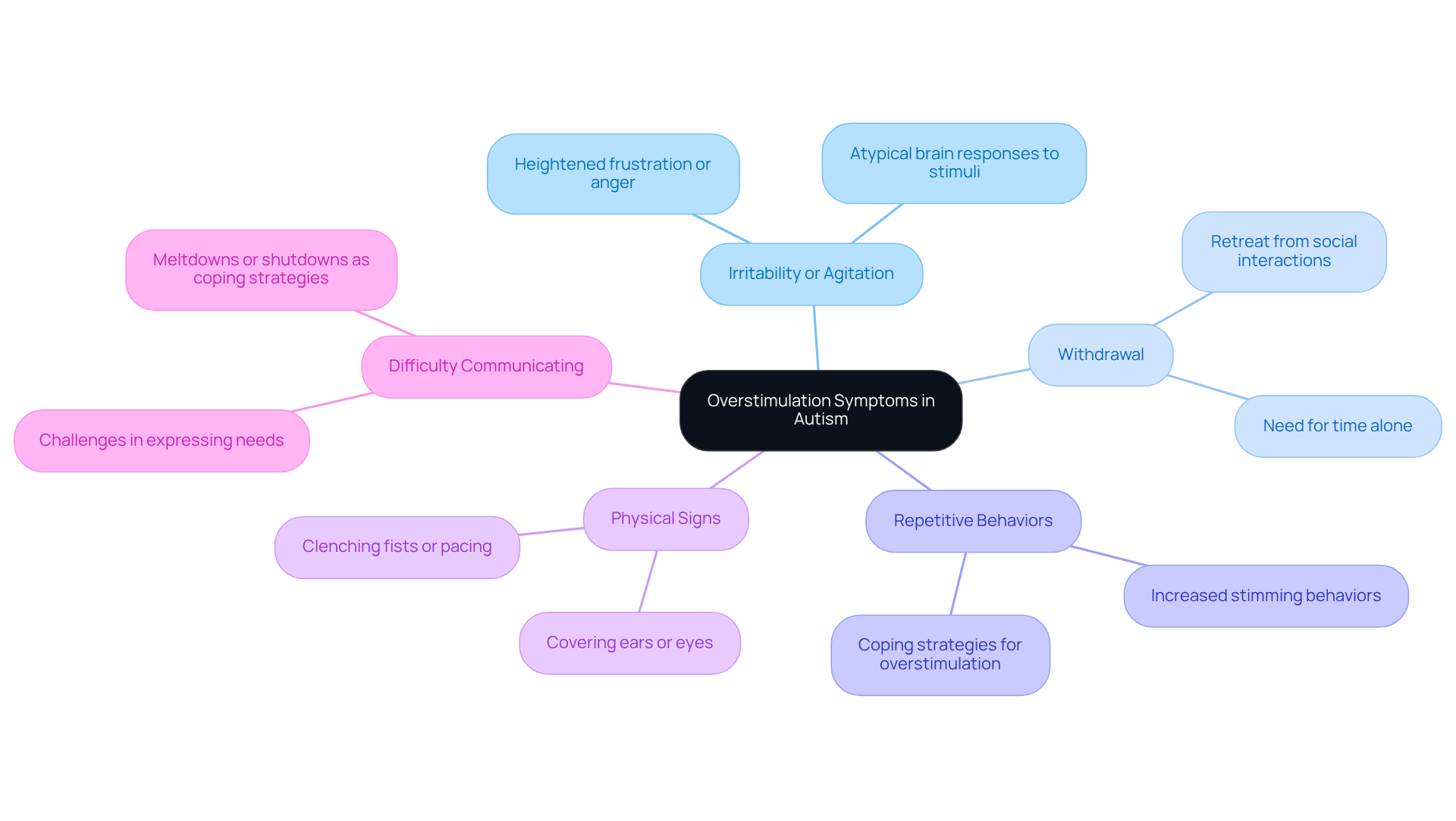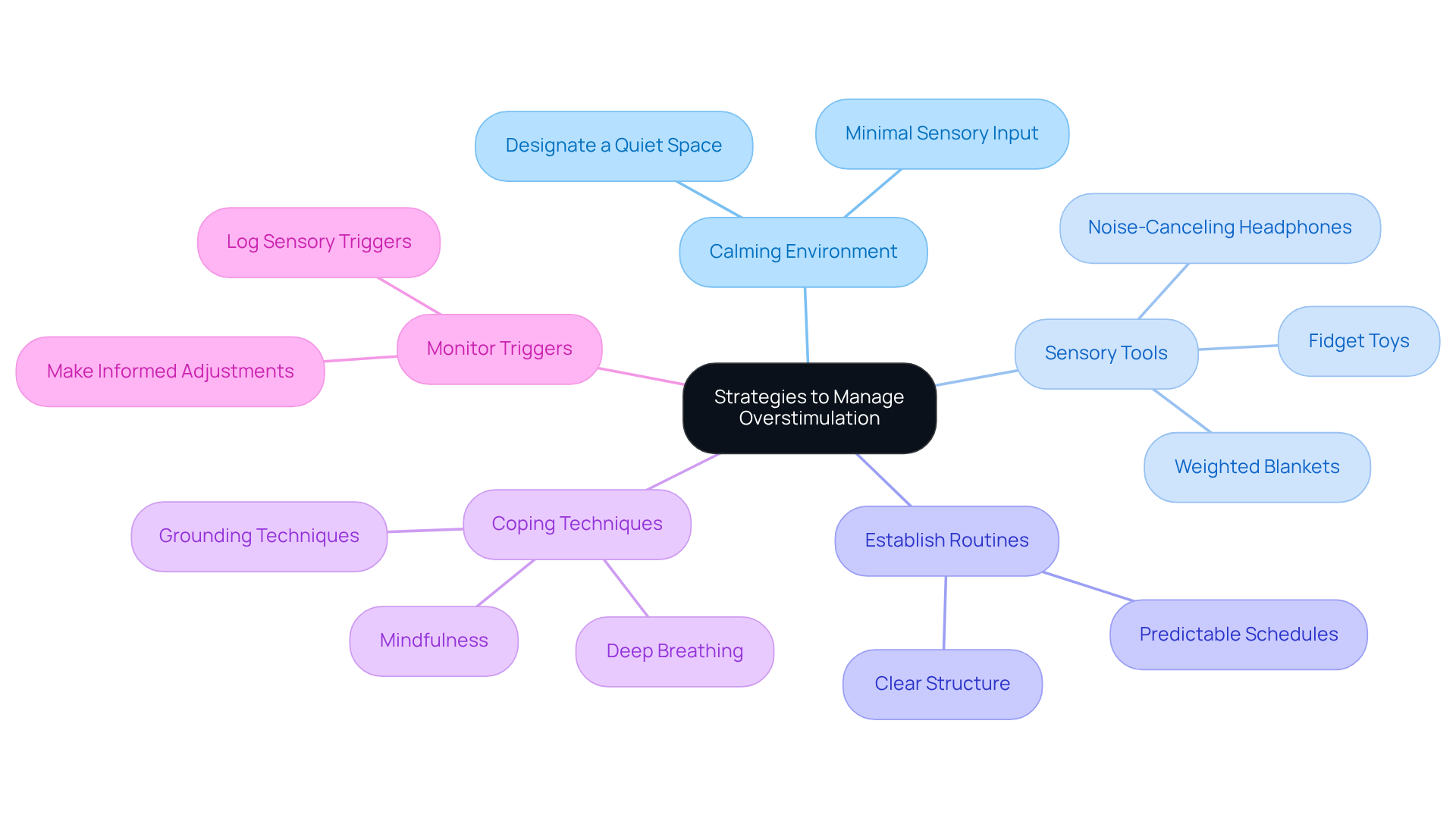Overview
Understanding autism overstimulation symptoms and their management is crucial for supporting individuals on the spectrum. Sensory overload can significantly impact their daily lives, making it essential to recognize symptoms such as irritability, withdrawal, and difficulty communicating. These challenges can be overwhelming not just for individuals, but also for their families.
Imagine a child who suddenly becomes agitated in a crowded place. This is a common scenario for many families. By identifying these symptoms early, we can take proactive steps to help. Creating calming environments and using sensory tools are practical strategies that can make a world of difference. These tools not only provide comfort but also empower individuals to navigate their surroundings more effectively.
As you consider these strategies, think about your own experiences. Have you noticed signs of overstimulation in your loved ones? Sharing your stories can foster a sense of community and support. By working together, we can create spaces that are more accommodating and understanding.
In conclusion, recognizing and managing autism overstimulation is not just about addressing symptoms; it’s about nurturing an environment where individuals feel safe and supported. Let’s take these steps together and make a positive impact on the lives of those we care about.
Introduction
Autism overstimulation, commonly known as sensory overload, poses a significant challenge for many individuals on the spectrum. This experience occurs when overwhelming sensory input floods the brain, resulting in distress and difficulties in daily life. Recognizing and managing these symptoms is essential for fostering supportive environments where autistic individuals can thrive.
What strategies can we implement to ease the effects of overstimulation and cultivate a sense of safety and comfort in their lives?
Define Autism Overstimulation and Its Impact
Autism overstimulation symptoms, commonly known as sensory overload, arise when a person with autism encounters an excessive amount of sensory input that their brain finds difficult to process. This experience can happen in various environments, such as crowded places, loud noises, or bright lights. The impact of autism overstimulation symptoms can lead to significant distress, anxiety, and behavioral challenges, making it difficult for individuals to engage in everyday activities or social interactions.
Understanding this phenomenon is essential for parents and professionals alike. By recognizing the signs of autism overstimulation symptoms, we can create supportive environments that help reduce these overwhelming experiences. It is vital to foster spaces where individuals feel safe and understood, allowing them to thrive and enjoy their daily lives.
If you or someone you know is navigating the challenges of autism and sensory overload, consider seeking resources and support. Connecting with others who share similar experiences can provide comfort and insight. Together, we can enhance well-being and promote a more inclusive world for everyone.

Identify Common Symptoms of Overstimulation in Autism
Recognizing the autism overstimulation symptoms in individuals with autism is essential, as these can significantly affect their daily lives. Key indicators include:
- Irritability or Agitation: Many autistic individuals may experience heightened frustration or anger when faced with overwhelming sensory input. This emotional response can escalate quickly if not addressed. Research by Green et al. (2019) highlights that children with autism often display atypical brain responses to stimuli, which contributes to these intense reactions.
- Withdrawal: A noticeable tendency to retreat from social interactions or environments can indicate that an individual is feeling autism overstimulation symptoms and needs some time alone.
- Repetitive Behaviors: Increased stimming behaviors like hand-flapping or rocking frequently serve as coping strategies to manage autism overstimulation symptoms.
- Physical Signs: Signs such as covering their ears or eyes, clenching their fists, or pacing can indicate autism overstimulation symptoms, signaling discomfort with their surroundings.
- Difficulty Communicating: Difficulty communicating needs or emotions can be particularly challenging, often resulting in autism overstimulation symptoms like meltdowns or shutdowns. These responses are frequently coping strategies for dealing with the autism overstimulation symptoms that arise from overwhelming stimuli.
For caregivers, recognizing autism overstimulation symptoms is crucial; taking prompt action can prevent escalation and help create a more supportive environment for individuals with autism.
It’s important to understand that over 90% of children with autism exhibit autism overstimulation symptoms, highlighting the prevalence of sensory challenges among autistic individuals. Moreover, self-regulation tools can empower autistic children to manage their perceptions and identify triggers for overstimulation, further enhancing their emotional well-being. By fostering an understanding of autism overstimulation symptoms and providing appropriate support, we can significantly improve their lives.

Implement Strategies to Manage Overstimulation
Managing autism overstimulation symptoms can be challenging, but with the right strategies, you can create a supportive environment for your loved ones. Consider these compassionate approaches:
-
Create a Calming Environment: Designate a quiet space where your child can retreat when feeling overwhelmed. This sanctuary, filled with minimal sensory input, can be a vital refuge.
-
Use Sensory Tools: Items like noise-canceling headphones, weighted blankets, or fidget toys can make a significant difference. These tools help regulate sensory input, assisting your child in managing autism overstimulation symptoms and finding comfort in moments of distress.
-
Establish Routines: Predictable schedules can be a source of security. By providing a clear structure, you can help reduce anxiety and assist your child in preparing for transitions.
-
Teach Coping Techniques: Encourage practices like deep breathing, mindfulness, or grounding techniques. These skills empower individuals to regain control during overwhelming moments, fostering resilience.
-
Monitor Sensory Triggers: Keeping a log of environments or situations that lead to overstimulation can be invaluable. This proactive approach allows you to make informed adjustments in the future.
Implementing these strategies not only enhances your ability to cope with sensory overload but also nurtures a deeper understanding of your child's needs. Remember, you are not alone in this journey—sharing your experiences can foster community and support.

Conclusion
Understanding autism overstimulation is essential for creating supportive environments for individuals with autism. By recognizing symptoms of sensory overload—such as irritability, withdrawal, and repetitive behaviors—caregivers and professionals can provide better assistance to those affected. Strategies like creating calming spaces, utilizing sensory tools, and establishing predictable routines offer practical approaches to effectively manage overstimulation.
In conclusion, this article underscores the significant impact of autism overstimulation on daily life. It highlights the necessity of recognizing common symptoms and implementing tailored strategies to help individuals navigate overwhelming sensory experiences. By fostering an understanding of these challenges, caregivers can enhance emotional well-being and cultivate supportive environments.
Ultimately, promoting awareness and empathy is crucial in addressing the symptoms of autism overstimulation. Encouraging open conversations and sharing experiences within the community can lead to a more inclusive world where individuals with autism can thrive. Taking proactive steps today can make a meaningful difference in the lives of those affected by sensory overload.
Frequently Asked Questions
What is autism overstimulation?
Autism overstimulation, commonly known as sensory overload, occurs when a person with autism encounters excessive sensory input that their brain struggles to process.
In what environments can autism overstimulation occur?
Autism overstimulation can happen in various environments, such as crowded places, loud noises, or bright lights.
What are the impacts of autism overstimulation symptoms?
The impacts can lead to significant distress, anxiety, and behavioral challenges, making it difficult for individuals to engage in everyday activities or social interactions.
Why is it important to understand autism overstimulation?
Understanding autism overstimulation is essential for parents and professionals to recognize its signs and create supportive environments that help reduce overwhelming experiences.
How can supportive environments help individuals with autism?
Supportive environments can foster spaces where individuals feel safe and understood, allowing them to thrive and enjoy their daily lives.
What should someone do if they are experiencing autism overstimulation?
It is advisable to seek resources and support, and to connect with others who share similar experiences for comfort and insight.




